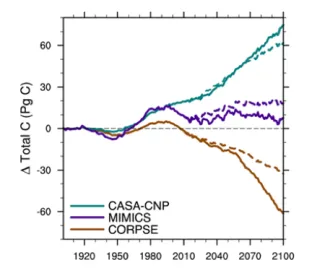Arctic Soil Governs Whether Climate Change Drives Losses or Gains in Soil Carbon
Date Published
Multiple models are needed to capture true uncertainty of soil carbon fate in a changing world.
Objective
- Evaluate three models that make different assumptions about factors responsible for persistence of carbon in soils.
- Because of these large carbon stocks, exchanges of carbon dioxide between soils and the atmosphere are large, and the potential responses of soil carbon stocks and fluxes to projected changes in climate are uncertain.
New Science
- Soils store carbon, lots of carbon; but is still needs to be resolved whether this carbon is vulnerable to loss in a changing climate.
- Key uncertainties in terrestrial carbon cycle projections revolve around the timing, direction, and magnitude of the carbon cycle feedback to climate change.
- This is especially true in carbon‐rich Arctic ecosystems, where permafrost soils contain roughly one third of the world's soil carbon stocks, which are likely vulnerable to loss.
Impact
- Although the different model formulations produce similar estimates for initial soil carbon stocks, there is a large spread in the fate of soil carbon under projected changes in soil temperature, moisture, and plant growth through the end of this century.
- These results highlight that researchers must develop and test model formulations that are consistent with observations and understanding—especially in the Arctic which has large soil carbon stores that are likely to experience rapid change in upcoming decades.
Citation(s)
Text
Wieder WR, BN Sulman, MD Hartman, CD Koven, and MA Bradford. 2019. Arctic soil governs whether climate change drives global losses or gains in soil carbon. Geophysical Research Letters 46:14486-14495. https://doi.org/10.1029/2019GL085543
Funding
This research was supported by the Director, Office of Science, Office of Biological and Environmental Research of the US Department of Energy under Contract No. DE-AC02-05CH11231 as part of the Next-Generation Ecosystem Experiments (NGEE Arctic) project.
For more information, please contact:
Benjamin Sulman
sulmanbn@ornl.gov

